Torun is one of Poland’s prettiest cities. Its medieval core was awarded the prestigious UNESCO World Heritage Status in 1997. The walled off city never changed its original layout. The fact that one can also visit Copernicus’s birthplace is a bonus.
|
 |
 |
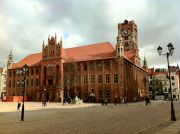 |
 |
 |
 |
 |
 |
The Townhall of the Old Town
 |
 |
At least in Poland, Torun is known for two facts. One is of course Nicolaus Copernicus (pol. Mikolaj Kopernik). The other is the honey ginger bread. Copernicus, who stopped the Sun and put the Earth in motion, was born in Torun on 19 February 1473 in a fine Gothic tenement house on Saint Anne Street, near the main square of the city. Now, the house is home to a museum dedicated to this courageous astronomer. And the street was re-named to bear his name.
UNESCO placed the following justification for including Torun on the World Heritage List: “Torun preserves to a remarkable extent its original street pattern and outstanding early buildings, providing an exceptionally complete picture of the medieval way of life. These buildings in Torun represent the highest achievement of medieval architecture in brick. Some of them, moreover, influenced the evolution of certain types of building. The town sets a standard for the evolution of towns in the region: the combination of two towns with a castle is a rare form of medieval settlement agglomeration. The unique special layout of Torun has survived almost intact and provides valuable source material for the history of town development in medieval Europe. ” The Old and New Towns were joined in 1454, yet parts of the dividing wall still remain.
The main train station (Torun Glowny) is on the other bank of the Vistula than the Old Town, but there is also a small train station (Torun Miasto) near the remains of the castle in the eastern part of the New Town. There are two significant features of the medieval centre. One is the picturesque square called Rynek Staromiejski, complete with the imposing townhall, whose tower offers fabulous views of Torun and beyond. The other is the pedestrianised artery running east-west across the city – ulica Szeroka. Both, the Rynek Staromiejski and the Szeroka Street, are the concentration of the places to eat and drink, go out and shop. The New Town also has a square - Rynek Nowomiejski.
|
|
| Favourite spots: |
 |
 |
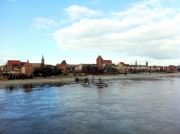 |
 |
 |
 |
 |
 |
Panorama of the historic Torun seen from the road bridge over the Vistula.
 |
 |
I was thinking for a while, whether there was a spot in Torun that I liked the most. The Rynek Staromiejski with the Old Town Townhall was great with the imposing St Mary's Church and its curious tri-tower facade looming in the north-west corner. The Rynek Nowomiejski, the heart of the New Town, was also cute with the incredible double roof tower of the St Jacob's Church. But I also liked the southern stretch of the city walls with the numerous gates and bastions. The best spot to see the city skyline was the road bridge running from the front of the Copernicus Univeristy Builing and the Leaning Tower south towards the main train station. From there, the historic centre seemed larger than it was and it looked fanstastic in the early hours of the morning and superb after sunset, when the clever illuminations of the most prominent features of the city were switched on. And they were being switched on gradually. Not all at once.
|
|
| What's really great: |
 |
 |
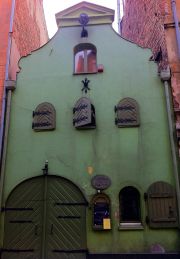 |
 |
 |
 |
 |
 |
The facade of the Tony Halik Travellers' Museum
 |
 |
The most interesting part of Torun is really compact. One can cover both, the Old Town and the New Town, thoroughly in a long day. Unless one will enter every single church and chapel and examine each Gothic, Renaissance, Baroque, Neoclassical (…) façade in detail, then a weekend is a must. Plus a slower pace also allows for the full appreciation of how this medieval urban gem is layout out.
The city has one remarkable museum. It is the Tony Halik Travellers’ Museum located on ulica Franciszkanska. It is based in a small old house and dedicated to Mr Tony Halik, an extremely popular Polish traveller, who did a number of TV series about his travels to the most exotic of places. The museum presents photos taken by Polish explorers during their journeys in the remote parts of our planet. The admission is free. At the time of my visit, there was a special exhibit dedicated to New Zealand.
|
|
| Sights: |
 |
 |
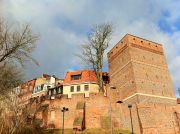 |
 |
 |
 |
 |
 |
The leaning tower of Torun
 |
 |
One of Torun’s curious sights is its own medieval leaning tower. In no, even smallest, detail does it resemble the famous one in Pisa. The Torun’s tower is less spectacular, however has a better story about it, I think. For this one, one of the many legends has it, had been erected this way on purpose – to be leaning towards the pavement. Apparently, it was a bet between two knights. One was claiming that it was impossible to build a leaning building. The other wanted to prove him wrong. One can try (in vain) standing against the leaning tower facing the pavement with their back against the front wall. Unless one is Michael Jackson, this is an impossible task. The tower today houses a bar/restaurant.
The other sights include: Old Town Townhall, Church of the Virgin Mary, University Building, Gothic Granary and Baroque Granary, both on ulica Piekary, Dambski Palace, Artus Court, Meissner Palace, Star House, St Johns' Cathedral, Church of St. Jacob with double roof on its bell tower.
|
|
| Accommodations: |
 |
 |
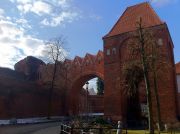 |
 |
 |
 |
 |
 |
One of the gates adjacent to the ruins of the Teutonic Knights' Castle and the Hotel 1231
 |
 |
I stayed at the four star Hotel 1231. It is located few yards from the remains of the castle of the Teutonic Order, who built it as a base for the evangelisation of Prussia (but it instead meant the base for annihilation of them and colonisation of their territory). The castle was destroyed by the uprising of the Torun residents against the Order in 1454, which effectively led to the Torun Peace Treaty of 1466, granting both Torun towns to Poland.
The hotel charged PLN300 (EUR75) per night for a single room with all the amenities of a European four star (lower end) establishment. The rooms were of a good size and cleaned well. The bathrooms were modern and had showers rather than bathtubs. The towels were show-white and spotless. I stayed in a larger double room #103 for PLN400. The staff were friendly and flexible allowing me to check out at 2pm rather than at noon. The restaurant downstairs was also excellent.
|
|
| Nightlife: |
 |
 |
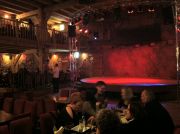 |
 |
 |
 |
 |
 |
Insight the Lizard King Music Club, before it got completely packed.
 |
 |
As I visited Torun on the last weekend of the Carnival, there was no shortage of parties to go to. The issue was choice and a challenge to get it. Everywhere was packed. First, I tried the Jazz Kot, a small cellar club playing decent tunes. It had two rooms with seats, one bar with friendly but not very efficient staff, and a dancefloor. Younger crowd frequented the venue as their prices were very reasonable. No cover charge, no door policy.
Then, I went to the Lizard King, close to Copernicus’s house. It was a large place with crowd representing good age range. The place got packed! Tables were positioned around the dancefloor and on a semi-circular balcony overseeing a small stage at the top of the dancefloor. Music was fantastic (1980s, 1990s) and bartenders new their stuff. I met a good mix of people - some from Greece and some from Albania. We drank mojitos, White Russians and tequila. There was remarkably no cover charge and the door policy was relaxed. The place closed at 4 a.m.
|
|
| Hangouts: |
 |
 |
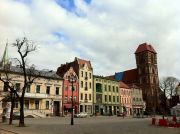 |
 |
 |
 |
 |
 |
The main square of the New Town (pol. Rynek Nowomiejski)
 |
 |
The locals liked to linger at the river bank, at the Bulward Filadelfijski. But there was nothing there. No place to sit down. Not even benches. Perhaps in the summer, there could be bars and restaurants on the boats tied in onto the norhtern bank of the Vistula, where it would be cool to chill.
From the cafes and bars perspective, I can report on a couple. One was the Chocolate Bar on ulica Szeroka, which served drinking chocolates, solid chocolates, chocolate covered ginger bread and pastries. The other one was the two level English pub called Kuranty, located in a tenement house on the Rynek Staromiejski. The ground floor was for non-smokers. Downstairs cellar was for smokers and those taking to the dancefloor. Both levels had a bar serving a good selection of beers, including Guinness from draft (PLN12). The place served excellent English tea (PLN9). Their kitchen did decent bar food (PLN15-PLN50), including a fine selection of pierogi, the famous Polish dumplings (PLN18-PLN24).
|
|
| Restaurants: |
 |
 |
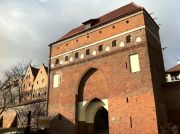 |
 |
 |
 |
 |
 |
The Monastery Gate (pol. Brama Klasztorna) in the southern fragment of the Old Town city walls.
 |
 |
Over the weekend, I visited several eateries, in addition to the aforementioned one at the hotel. A very popular Chinese one called Lotus (ul. Strumykowa), which served excellent value tasty dishes and shabby wine, where service was exceptionally swift. A very small French one called Prowansja, where I had great wine (Nobile di Montelpuciano, PLN105) and a mixed starter with cheeses, olives, grapes and savoury cookies (PLN18). An interesting Indian one called Royal India (ul. Prosta) serving a good choice of unsurprising, decent Indian meals of which garlic chilli lamb was best (PLN33) and very good lassi (PLN10), where service was unacceptably slow. An old Polish one called Gottica, located in the cellar of the Old Town Townhall, where I tried the sour soup called ‘zurek’ that set me back by PLN6, but arrived in no time at all. A fabulous Japanese sushi one called Dom Sushi serving dishes on little boats floating around the chef. And I did try some food at the aforementioned Kuranty.
|
|
| Other recommendations: |
 |
 |
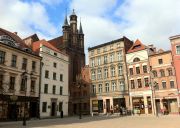 |
 |
 |
 |
 |
 |
The main square of the Old Town (pol. Rynek Staromiejski)
 |
 |
I was under the impression that Torun still had a fair bit to do in order to renovate and revitalise some of its monuments. Sadly, it was too obvious that the city had underinvested its appearance for a very long time. Some ancient structures were in an alarming state of disrepair, mainly the old warehouses and free standing residential buildings, most of which could be converted in fantastic hotels or pensions. A large number of the fabulously preserved little side streets within the city walls looked scary and unwelcoming (it might have been done on purpose, although I did not really think so), and which would look superb with clever and delicate street lighting. Having said that, I do have to admit that it was clearly visible that the city, supported by the European Union, was spending millions and millions of euros on the renovation of some grand palaces, mansions and prominent buildings, as well as the city walls, gates, towers and bastions.
|
|
Published on Monday March 7th, 2011
|
|
 Publish on Facebook
Publish on Facebook
|
Sat, Mar 19 2011 - 10:32 AM
 by jorgesanchez
Not only interesting report, but very didactic. Thanks.
|
Tue, Mar 08 2011 - 06:26 PM
 by eirekay by eirekay
| You continue to take me place I didn't realize I wanted to go to!! Thank you Krys! |
| Information: |
| Login if you are a member, or sign up for a free membership to rate this report and to earn globo points! |
|
| Grenada |
|
|
 |
| Guatemala |
|
|
 |
| Guernsey |
|
|
 |
| Guinea-Bissau |
|
|
 |
| Guyana |
|
|
 |
| Honduras |
|
|
 |
| Hong Kong |
|
|
 |
| Hungary |
|
|
 |
| Iceland |
|
|
 |
| India |
|
|
|
|
|
|
|
|
 |
| Indonesia |
|
|
|
|
|

|
